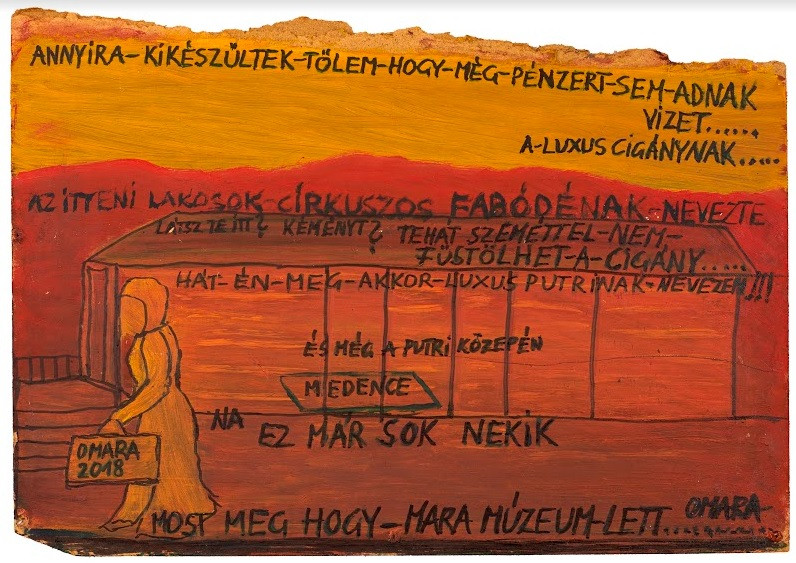OMARA - Mara Oláh
They are so fed up with me that they won't even give me water for money…
To the luxury gypsy…
The residents here called it a circus fable.
Do you see a chimney here? So the gypsy can't smoke with rubbish…
Well, I call it a luxury hut!!!
And in the middle of the hut
Pool
That's too much for them
Now that Mara has become a museum…, 2018
The stormy rains are showing their power. I hope you take this opportunity to get a job, so the bandits won’t be harvesting. If not, then blame yourself, because you’re stupid. Keep on mowing the grass for peanuts and letting yourself get murdered. Borsod- Abaúj - Zamplén County May 2010, 2010
My God Damn You, racist miser, this is my message to you. I am the painter Omara. You were allowed to kill them just because they were Gypsies. Shame on you Hungarian people, Respect to the exceptions., 2009
You are not wrong. Who are you all? Murderers? Are you proud of that? Don't you want the gas chambers?, 2009
📍 Venue → GHMP

We can understand the paintings on display by OMARA – Mara Oláh to be her responses to racism and expressions of her anger. Oláh makes it clear that she will not ignore her anger; she will not be silent about it either. As the African American poet Audre Lorde wrote regarding racism and anger: “My fear of that anger taught me nothing. Your fear of that anger will teach you nothing, also.” How can we come to terms with anger? How can we exist with anger? How can we listen to anger? Mara Oláh was a self-taught artist who started to paint in her forties. Her paintings and drawings usually represent real occurrences and include poetic inscriptions to highlight her emotional state. She used art to come to terms with the traumas of her life as well as the difficulties resulting from her position as a Romani woman in Hungary.
OMARA – Mara Oláh (1945–2020) started painting at the age of 43, after her mother’s death. Parallel with her autobiography, she painted the major traumas in her life in chronological order, using art as a therapeutic tool to come to terms with and overcome humiliation, the grief felt over losing her mother, the anguish of alienation from her daughter, and the physical pain of her cancer. Since 1992 all her pictures have been completed with inscriptions. Painted in various tones of blue and complemented with textual explanations and words of wisdom, the “blue pictures” are confessions about the artist’s most important personal experiences, her relationship with her daughter, and her ordeals as a Roma and a woman. In 1993 she opened Hungary’s very first private art gallery in her home in the Kispest neighborhood of Budapest, and in 1997 she self-published her autobiography OMara festőművész [Painter Omara]